Innovative Clear Solar Panels for Efficient Energy Harvesting and Enhanced Building Design
The Future of Energy Transparent Solar Panels
As the world grapples with the pressing challenges of climate change and energy consumption, innovative technologies are emerging to address these issues. One such groundbreaking innovation is transparent solar panels, a game-changing advancement in the renewable energy sector that possesses the potential to transform how we harness solar energy.
Transparent solar panels function by allowing sunlight to pass through while simultaneously capturing a portion of the solar energy for electricity generation. This technology enables sunlight to filter through windows, facades, and even mobile devices, seamlessly integrating into the architecture without obstructing the view. The invention of these panels has opened a new chapter in solar energy utilization; it requires minimal space and can utilize surfaces typically not associated with energy generation.
The fundamental principle behind transparent solar panels is simple yet sophisticated. Traditional solar panels use opaque silicon photovoltaic cells to generate energy, whereas transparent panels rely on organic photovoltaics or dye-sensitized solar cells. These materials can absorb specific wavelengths of light, converting sunlight into electricity while remaining partially see-through. The development of these materials is crucial, as they strike a balance between transparency and light absorption.
One of the most promising applications of transparent solar technology is in urban environments where space is at a premium. Imagine skyscrapers equipped with high-rise windows made of transparent solar panels. Such buildings could significantly reduce their reliance on traditional energy sources, producing clean energy while promoting sustainable architecture. Furthermore, this technology could be applied to vehicle windows and solar-powered smart devices, enhancing energy efficiency without compromising design.
transparent solar panels

Transparent solar panels are not only aesthetically pleasing but also economically advantageous. By integrating solar technology into existing infrastructures, businesses and homeowners can reduce energy bills and potentially generate revenue by feeding excess power back into the grid. This creates a win-win situation where property owners can benefit financially while contributing to a greener planet.
Despite the apparent benefits, the adoption of transparent solar panels faces several challenges. The efficiency of transparent solar panels is currently lower than that of conventional solar panels, which may deter some users. However, research and development are ongoing, and advancements in materials science may lead to improvements in energy conversion rates over time. Increasing public awareness and interest in sustainable technology can also drive investments in this field, speeding up the adoption of transparent solar technologies.
Moreover, regulatory hurdles and the need for standardization in installation methods could slow down the widespread deployment of transparent solar panels. Governments and organizations must work hand in hand to create policies that foster innovation while ensuring safety and efficacy in implementation.
Looking ahead, the potential market for transparent solar panels is enormous. As urbanization continues to rise and the demand for energy increases, the need for innovative solutions will become more critical. Transparent solar technology represents a potentially transformative approach to energy generation in a world striving for sustainability.
In conclusion, transparent solar panels embody the remarkable advancements in renewable energy technology. Their unique ability to blend seamlessly into everyday structures while generating clean electricity presents a revolutionary opportunity for reducing our carbon footprint and enhancing energy efficiency. As research continues, and their efficiency and cost-effectiveness improve, transparent solar panels could soon become a staple in both urban landscapes and our daily lives. Embracing this innovation may lead to a more sustainable future, highlighting the crucial intersection of technology, environment, and architecture.
-
String Solar Inverter: The High-Efficiency Solution for Smart Solar EnergyNewsJul.14,2025
-
Revolutionizing Rooftop Energy with the Power of the Micro Solar InverterNewsJul.14,2025
-
Power Independence with Smart Off Grid Solar Inverter SolutionsNewsJul.14,2025
-
On Grid Solar Inverter: Powering the Future with Smart Grid IntegrationNewsJul.14,2025
-
Monocrystalline Solar Panels: High-Efficiency Power for the Future of Clean EnergyNewsJul.14,2025
-
Bifacial Solar Panel: A Smarter Investment for Next-Generation Energy SystemsNewsJul.14,2025







